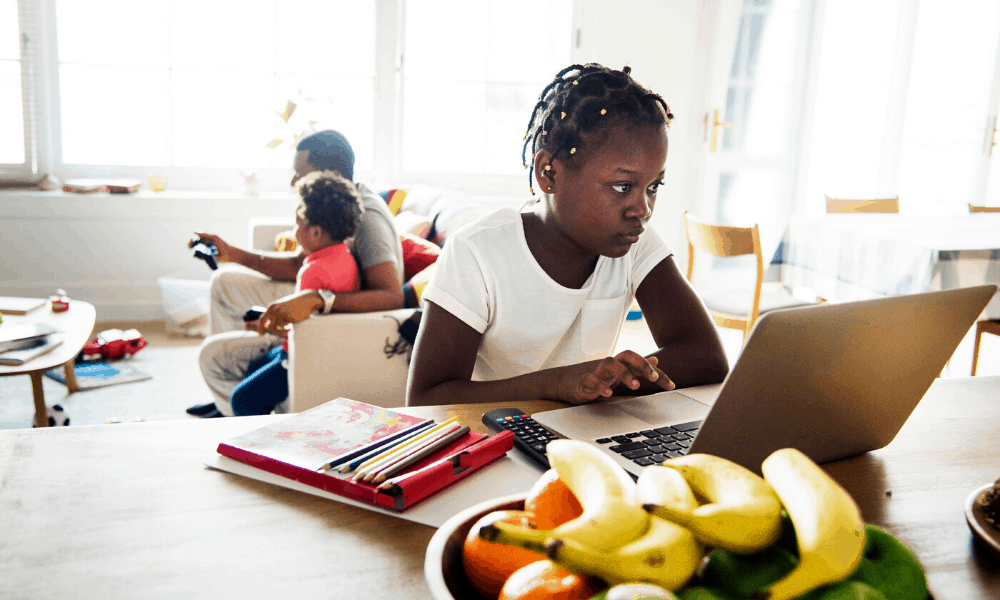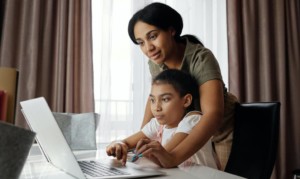The Impact Of A Pandemic: What To Do As A Parent And What Will Happen In Higher Ed

By: Michael Horn
In these turbulent times, children’s schools are shutting down across the country. As I write this, roughly 40 million K–12 children are out of school in the United States, according to Education Week’s interactive map. That’s out of 51 million public school students and 5.8 million private school students. My current belief is that most schools will not reopen this school year.
Although I normally send out a monthly eblast about the future of education, to state the obvious, these aren’t normal times. Given the challenges we are all facing and the inquiries I’ve received from many of you asking what are we doing in the Kim-Horn household, what online resources are useful, and the like, here are some thoughts and resources that I hope prove helpful.
Please treat these as ideas to guide, not direct definitively. Just as there is no one best way to educate a child, there is no one best course of action amidst this crisis. You’ll need to find the right way forward in your circumstance for your family. My wife, Tracy, and I have seen plenty of amazing ideas out there—that just aren’t right for our family given we have twin daughters who are five. I also readily acknowledge that we’re fortunate to have the lives we do and are able to make certain decisions that others might not be able to make. Bottom line? You do you and stick to it.
And I assure you that we’re making plenty of daily mistakes. We are all learning together—and we won’t stop. If you have other ideas and tips, reach out to me over Twitter (@michaelbhorn). I’ll be sure to amplify productive conversations so we can all benefit.
The routine
We’re big believers in trying to have a consistent routine to give our children a rhythm to the day and a sense of security and stability that comes from having some certainty and control. We also try to alternate between activities that require our children to take an “in breath” and those that allow them to take an “out-breath.”
As we build a new routine, we’re figuring out ways to make sure that Tracy and I can do work while our daughters get what they need. It’s a work in progress, but our basic strategy is to take shifts with the children and make sure we have some overlapping times so we can be together as a family and as a couple. We’re trying not to be too hard on ourselves when we mess up—or when we have to do a bit more mindless screen time than we might otherwise do in a pinch.
Given that so many have inquired, here’s our children’s basic schedule (and yes, it’s a work in progress):
| Activity Block |
| Wake-up routine (get dressed, journal, etc) |
| Eat breakfast + clean up |
| Walk our dog |
| Family individual reading time (20 min) |
| Digital learning time (Could be circle time with school, a program, Facetime, etc. 20-30 min) |
| Morning activity: 3 days a week we are outdoors; 3 days a week they do STEAM (science, technology, engineering, arts, math) projects and the like |
| Clean up, help make lunch, eat, clean up |
| Quiet hour (we are all by ourselves with choice around what we do) + 15 minutes for each child to practice piano or have a lesson |
| Free time (Besides play, opportunities for STEAM challenges or projects, food prep, gardening, bike riding, writing a daily letter and addressing it, etc.) |
| Dinner, clean up, nightly routine |
A key pillar of our schedule is that our children are going to be a more integral part of our household work with the hope that that helps us have the time we need to work and invest in our own well being. As my late mentor Clay Christensen wrote in How Will You Measure Your Life, when he was growing up:
“We had gardens and fruit trees; we grew a lot of what we ate…. The idea that one might hire someone else to mow the lawn and shovel the snow at your home—it just never happened. There was so much work going on that children essentially worked for their parents. Step by step, over the past fifty years, it has become cheaper and easier to outsource this work to professionals. Now the only work being done in many of our homes is a periodic cleanup of the mess that we make. In the absence of work, we’ve created a generation of parents who selflessly devote themselves to providing their children with enriching experiences.”
Given the current circumstances, although we aren’t reverting fully to how Clay grew up, we are reversing some of today’s parenting culture out of necessity. We also know that we enjoy many blessings that enable us to do things that others can’t.
I’ll say it again, though. You ultimately have the children you have—not ours—in your own context, so make sure whatever you do is personalized for them and your circumstances. I’m a big believer in active learning experiences that are personalized for the child’s needs. These times are no different in that respect.
Leaning on home-schooling parents’ tips can be helpful for coming up with your own plan for the day if you have children who are now at home. But I’d caution that because their children weren’t in school, the context might be different—and your personal work circumstances may be very different.
I personally found this article by my friend Mike Goldstein, an educator who founded the Match charter schools in Boston and has worked in a wide range of educational contexts, incredibly helpful: “Coronavirus closing your kid’s school? One parent’s plan for Daddy School.” It contains his routine plus resources.
Finally, here are some tips from Prepared Parents, along with a way to follow their advice on Instagram and Facebook. Leveraging a self-directed learning plan and children’s natural curiosity makes a lot of sense to me.
Online resources
Now I know I’m not a parenting expert. Trust my wife on that one. Most of the questions coming to me have been about online-learning resources. So, here are a few of what I’ve found to be useful. Everything here is currently free.
- NewSchools Venture Fund: They compiled a Google spreadsheet here filled with stellar resources. Want math curriculum? They’ve got you covered, with links on providers ranging from ST Math to Zearn. Reading and writing on your mind? They have resources like Newsela and Quill. They have history, science, and more. Check it out. What’s great is it’s not overwhelming, and everything on it has a strong reputation.
- Khan Academy: They’ve set up a great help desk for how Khan Academy can be used during school closures here, and you can view their suggested daily routines by grade level here.
- Barbara Bush Foundation for Family Literacy: The Foundation has created a wonderful education toolkit for at-home learning filled with free resources that can continue to help children build literacy skills while at home. From read-aloud books to reading games, there’s a lot you have at your disposal.
The impact on colleges and universities—and education more generally
With campuses shutting down, what’s the impact of the COVID-19 disease likely to be on colleges across the country?
Jeff Selingo and I turned to someone on our Future U podcast who has deep expertise with this question—Scott Cowen, who led Tulane University in the aftermath of Hurricane Katrina. His big advice centered around maintaining 3 things:
- Communication
- Transparency
- Community
We then followed up in our next Future U episode with an interview of two people on the front lines of helping colleges transition to “remote learning.” We talked to the provost of West Chester University, a regional public university in Pennsylvania, and a faculty member at Ithaca College, a private college in New York, about what it’s really like to turn a residential campus into a virtual one overnight.
This piece at WGBH, “Organized Chaos’: Many Mass. Colleges Unprepared For Transition To Online Teaching,” offers some great color on what this transition to remote learning looks like as well, with a sense of the challenges and opportunities everyone from schools of music to community colleges are facing.
So with colleges all moving to “remote” and online learning, will this crisis turn out to be a “black swan” moment for higher education to the benefit of online learning, as Goldie Blumenstyk argues at the Chronicle for Higher Education?
I think it depends upon the duration of this moment, but my initial reaction was to be skeptical. With professors hastily moving courses online, I just don’t think the experiences will be all that compelling—particularly if the interruption is temporary. You can read more at Education Next in “Covid-19 Boost to Online Learning May Backfire.”
Or check out a podcast I did for Education Next on the topic here where we dive into not just the implications for online learning in higher education, but also K–12 schools and how districts might think of equity concerns and the like.
You can also read a fuller set of perspectives that Inside Higher Ed published on the topic, “Will Shift to Remote Teaching Be Boon or Bane for Online Learning?” In my contribution, I also offered four tips to faculty members moving their courses online. One of the tips is to remember that online learning isn’t about putting the faculty member front and center like massive open online courses (MOOCs) did.
Amidst some of my concerns, however, there are big bright spots. Everest Education, an after-school company in Vietnam, has been doing a lot of R&D on online learning for some time. With the shutdown of the nation’s schools and after-school programs, they have rolled their active online platform and pedagogy out to the country—which could be a big benefit to families and the nation. Have a read—“Amidst COVID-19’s Spread, Hope For Education Innovation Glimmers In Vietnam”—on Forbes.
I hope that, during these troubled times, that story brightens your day and gives you some hope. Even as we practice “physical distancing,” let’s remember to keep our social solidarity strong.
For more, see:
- Getting Through: Supporting Learners as They Transition to School at Home
- Teachers Teach: Content, Online Tools, Assessment
- Podcast: Rachel Wigglesworth on Learning at Home
Stay in-the-know with innovations in learning by signing up for the weekly Smart Update.
Getting Smart has launched the Getting Through series to support educators, leaders, and families on the path forward during such an uncertain time. This series will provide resources and inspiration as we face long term school closures, new learning environments, and address equity and access from a new lens. Whether you are just getting started with distance or online learning, or you’ve had plans in place and have the opportunity to share your work and guidance with others, there is a place for your voice and an opportunity to learn.
We’re going to get through this together, and we invite you to join us. Please email [email protected] with any questions or content you’d like considered for publication. We also invite you to join the conversation and on social media using #GettingThrough.
Michael Horn is the Chief Strategy Officer at Entangled Solutions and author of Choosing College and Blended






0 Comments
Leave a Comment
Your email address will not be published. All fields are required.